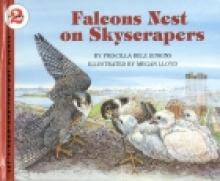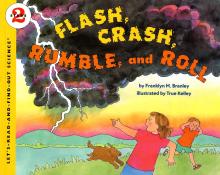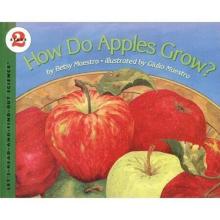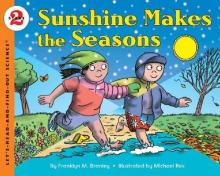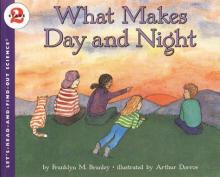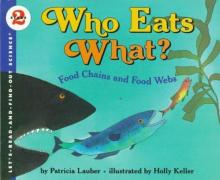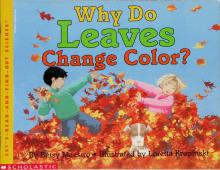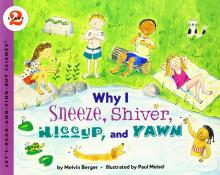No name
Falcons Nest on Skyscrapers
This is a very interesting book (with excellent illustrations) that introduces young children to various falcons living in the United States, some of their remarkable abilities and the story of how some scientists were successful in re-introducing the peregrine falcon in the Eastern United States after they nearly became extinct because of an insect spray called DDT which was overused earlier in the twentieth century. The story focuses on Scarlett, a peregrine falcon who was born in captivity, released, and discovered building a nest thirty-three stories up on the ledge of a skyscraper in Baltimore. This location made observation ideal and we learn that she managed to find a wild falcon for a mate and that their offspring have helped significantly in restoring the falcon population.
Flash, Crash, Rumble and Roll
This simple, nicely illustrated (cartoon-like pictures) children's book explains important concepts of science in a very easy-to-understand fashion. The reader is introduced to the way thunderclouds form and where thunder and lightning come from. The scientific content is substantial and very accessible. The story line is rounded out with tips for staying safe during a storm. My children have been fascinated by the details about the inside of a thundercloud, how fast sound and light travel, how you can measure the distance thunder travels and more. This title has been a big favorite with all of my children for a number of years and, rather than being made nervous by the dangers mentioned in the book, a little knowledge seems to be a comforting thing.
How do Apples Grow?
The development of apples is presented, from leaf and flower buds in the winter, thru blossoms in the spring, pollination and the actual growth of the apple. In addition to beautiful scenic pictures of trees in blossom and bees pollinating the trees, there are more technical drawings which illustrate the parts of a flower, show flowers in the different stages of development and show the connections between the original blossom and the ripe apple. The text also introduces some important terminology that will be useful in later science studies (pollen, stamen, pistil, etc.). Overall, a very nice and useful book.
How do Birds Find Their Way?
A nicely illustrated and interesting look at the amazing phenomenon of bird migration, what we know about how migration works and some various theories about details that are still being studied. Includes a chart of how high various birds fly.
Sunshine Makes the Seasons
"Sunshine warms the earth. If the sun stopped shining, the earth would get colder and colder..." It is important for children to consider the importance of the sun in our lives. In Sunshine Makes the Seasons, children are introduced to the sun's role and in particular how the seasons change because of the earth's rotation around the sun and the tilt of the earth.
In a fashion similar to The Moon Seems to Change, an experiment involving an orange stuck into a pencil (again a styrofoam ball and a chopstick or pencil will work just as well) helps to illustrate the various points that are explained. First the child uses a flashlight with the "axis" of the earth pointed straight up and down to show how the seasons would always be the same in that scenario. Then we are shown that by tilting the earth, the length of each day changes throughout the year. We also see how the North and South Pole are special cases where the midwinter can have several weeks of darkness and midsummer can have continuous light. We also see that the seasons change very little at the equator and that the Northern and Southern hemispheres have opposite seasons from each other. Again, this book covers substantial information in a very simple way and will be very useful and straightforward for early science lessons.
What Makes Day and Night?
The clearly written text is combined with simple, colorful pictures to make the concepts of day and night and the rotation of the earth in relation to the sun very understandable for both young children and their parents. : ) Included is a very simple hands-on "experiment" requiring only your child and a desk lamp. Some information about the moon is also covered. Like other books in this series, this book is a great solution for satisfying some of those "why" questions that young children constantly ask.
Who Eats What? Food Chains and Food Webs
This book explores the notion of various plants and animals that are linked together based on "who eats what." Children will learn about some simple food chains such as – leaf, caterpillar, wren and hawk. They also see how one plant or animal can belong to several food chains and that members or these related food chains (food webs) have a certain amount of dependence on each other. The text goes on to explain, through an example of a problem with over-hunted otters around the turn of the century, that when part of a food chain is disturbed, the other members will also be affected. There are some mild "environmental" messages in this text which our family used as an opportunity to discuss good stewardship of what God has given us.
Why Do Leaves Change Color?
Our family has really enjoyed this book which explains why leave fall off the trees before winter, where the different colors come from, how weather affects the brilliancy of the colors and lots more. It's written in a very simple manner, so that it's quite understandable even for preschoolers or kindergarteners, and yet it contains substantial information so that even moms (like me) realize that they don't know everything : ) You'll also find labeled pictures of the leaves from different kinds of trees, a cross section of a leaf, an explanation of how trees make food, and how to make leaf rubbings and preserve leaves by ironing them between sheets of waxed paper.
Why I Sneeze, Shiver, Hiccup and Yawn
A simple book with cartoon-like illustrations that explains reflexes and the related workings of the nerovus system – focusing, of course, on those four topics mentioned in the title. The story also invites children to try out a few simple experiments to observe reflexes for themselves. A "Find Out More" section provides "Things to Think About", additional "Test Your Reflexes" ideas and "Fun Facts".

